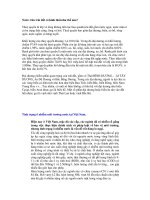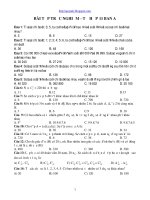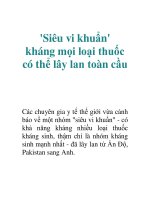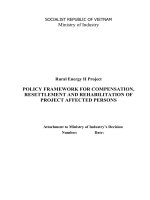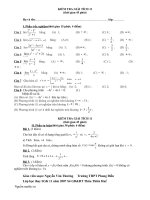Tài liệu Engineering Mechanics - StaticsChapter 1Problem 1-1 Represent each of the following combinations of units in the correct SI form using an appropriate prefix: (a) m/ms (b) μkm (c) ks/mg (d) km⋅ μN Units Used: μN = 10−6N kmμkm = 109−6Gs = 10 s pptx
Bạn đang xem bản rút gọn của tài liệu. Xem và tải ngay bản đầy đủ của tài liệu tại đây (20.21 MB, 1,119 trang )
Engineering Mechanics - Statics Chapter 1
Problem 1-1
Represent each of the following combinations of units in the correct SI form using an
appropriate prefix:
(a)
m/ms
(b)
μ
km
(c)
ks/mg
(d)
km μN⋅
Units Used:
μN10
6−
N=
μkm 10
6−
km=
Gs 10
9
s=
ks 10
3
s=
mN 10
3−
N=
ms 10
3−
s=
Solution:
a()
m
ms
110
3
×
m
s
=
m
ms
1
km
s
=
b() μkm 1 10
3−
× m=
μkm 1mm=
c()
ks
mg
110
9
×
s
kg
=
ks
mg
1
Gs
kg
=
d() km μN⋅ 110
3−
× mN=
km μN⋅ 1mmN⋅=
1
© 2007 R. C. Hibbeler. Published by Pearson Education, Inc., Upper Saddle River, NJ. All rights reserved.
This material is protected under all copyright laws as they currently exist. No portion of this material may
be reproduced, in any form or by any means, without permission in writing from the publisher.
Engineering Mechanics - Statics Chapter 1
Problem 1-2
Wood has a density d. What is its density expressed in SI units?
Units Used:
Mg 1000 kg=
Given:
d 4.70
slug
ft
3
=
Solution:
1slug 14.594 kg=
d 2.42
Mg
m
3
=
Problem 1-3
Represent each of the following combinations of units in the correct SI form using an
appropriate prefix:
(a)
Mg/mm
(b)
mN/
μ
s
(c)
μmMg⋅
Solution:
a()
Mg
mm
10
3
kg
10
3−
m
=
10
6
kg
m
=
Gg
m
=
Mg
mm
Gg
m
=
b()
mN
μs
10
3−
N
10
6−
s
=
10
3
N
s
=
kN
s
=
mN
μs
kN
s
=
c() μmMg⋅ 10
6−
m
()
10
3
kg
()
= 10
3−
mkg⋅=
μmMg⋅ mm kg⋅=
2
© 2007 R. C. Hibbeler. Published by Pearson Education, Inc., Upper Saddle River, NJ. All rights reserved.
This material is protected under all copyright laws as they currently exist. No portion of this material may
be reproduced, in any form or by any means, without permission in writing from the publisher.
Engineering Mechanics - Statics Chapter 1
Problem 1-4
Represent each of the following combinations of units in the correct SI form:
(a)
Mg/ms,
(b)
N/mm,
(c)
mN/(
kg μs⋅
).
Solution:
a()
Mg
ms
10
3
kg
10
3−
s
=
10
6
kg
s
=
Gg
s
=
Mg
ms
Gg
s
=
b()
N
mm
1N
10
3−
m
= 10
3
N
m
=
kN
m
=
N
mm
kN
m
=
c()
mN
kg μs⋅
10
3−
N
10
6−
kg s⋅
=
kN
kg s⋅
=
mN
kg μs⋅
kN
kg s⋅
=
Problem 1-5
Represent each of the following with SI units having an appropriate prefix:
(a)
S
1
,
(b)
S
2
,
(c)
S
3
.
Units Used:
kg 1000 g= ms 10
3−
s= kN 10
3
N=
Given:
S
1
8653 ms=
S
2
8368 N=
S
3
0.893 kg=
Solution:
a() S
1
8.653 s=
3
© 2007 R. C. Hibbeler. Published by Pearson Education, Inc., Upper Saddle River, NJ. All rights reserved.
This material is protected under all copyright laws as they currently exist. No portion of this material may
be reproduced, in any form or by any means, without permission in writing from the publisher.
Engineering Mechanics - Statics Chapter 1
b() S
2
8.368 kN=
c() S
3
893g=
Problem 1-6
Represent each of the following to three significant figures and express each answer in SI units
using an appropriate prefix:
(a)
x,
(b)
y, and
(c)
z.
Units Used:
MN 10
6
N=
μg110
6−
× gm=
kN 10
3
N=
Given:
x 45320 kN=
y 568 10
5
×
()
mm=
z 0.00563 mg=
Solution:
a() x 45.3MN=
b() y 56.8km=
c() z 5.63μg=
Problem 1-7
Evaluate (
ab⋅
)/c to three significant figures and express the answer in SI units using an
appropriate prefix.
Units Used:
μm10
6−
m=
Given:
a 204 mm()=
4
© 2007 R. C. Hibbeler. Published by Pearson Education, Inc., Upper Saddle River, NJ. All rights reserved.
This material is protected under all copyright laws as they currently exist. No portion of this material may
be reproduced, in any form or by any means, without permission in writing from the publisher.
Engineering Mechanics - Statics Chapter 1
b 0.00457 kg()=
c 34.6 N()=
Solution:
l
ab
c
= l 26.945
μmkg⋅
N
=
Problem 1-8
If a car is traveling at speed v, determine its speed in kilometers per hour and meters per second.
Given:
v 55
mi
hr
=
Solution:
v 88.514
km
hr
=
v 24.6
m
s
=
Problem 1-9
Convert: (a) S
1
to
Nm⋅
, (b) S
2
to kN/m
3
, (c) S
3
to mm/s. Express the result to three
significant figures. Use an appropriate prefix.
Units Used:
kN 10
3
N=
Given:
S
1
200g lb ft⋅=
S
2
350g
lb
ft
3
=
S
3
8
ft
hr
=
5
© 2007 R. C. Hibbeler. Published by Pearson Education, Inc., Upper Saddle River, NJ. All rights reserved.
This material is protected under all copyright laws as they currently exist. No portion of this material may
be reproduced, in any form or by any means, without permission in writing from the publisher.
Engineering Mechanics - Statics Chapter 1
Solution:
a() S
1
271N m⋅=
b() S
2
55.0
kN
m
3
=
c() S
3
0.677
mm
s
=
Problem 1-10
What is the weight in newtons of an object that has a mass of: (a) m
1
, (b) m
2
, (c) m
3
? Express
the result to three significant figures. Use an appropriate prefix.
Units Used:
Mg 10
3
kg=
mN 10
3−
N=
kN 10
3
N=
Given:
m
1
10 kg=
m
2
0.5 gm=
m
3
4.50 Mg=
Solution:
a() Wm
1
g=
W 98.1 N=
b() Wm
2
g=
W 4.90 mN=
c() Wm
3
g=
W 44.1 kN=
6
© 2007 R. C. Hibbeler. Published by Pearson Education, Inc., Upper Saddle River, NJ. All rights reserved.
This material is protected under all copyright laws as they currently exist. No portion of this material may
be reproduced, in any form or by any means, without permission in writing from the publisher.
Engineering Mechanics - Statics Chapter 1
Problem 1-11
If an object has mass m, determine its mass in kilograms.
Given:
m 40 slug=
Solution:
m 584 kg=
Problem 1-12
The specific weight (wt./vol.) of brass is
ρ
. Determine its density (mass/vol.) in SI units.
Use an appropriate prefix.
Units Used:
Mg 10
3
kg=
Given:
ρ
520
lb
ft
3
=
Solution:
ρ
8.33
Mg
m
3
=
Problem 1-13
A concrete column has diameter d and length L. If the density (mass/volume) of concrete is
ρ
,
determine the weight of the column in pounds.
Units Used:
Mg 10
3
kg=
kip 10
3
lb=
Given:
d 350 mm=
L 2m=
7
© 2007 R. C. Hibbeler. Published by Pearson Education, Inc., Upper Saddle River, NJ. All rights reserved.
This material is protected under all copyright laws as they currently exist. No portion of this material may
be reproduced, in any form or by any means, without permission in writing from the publisher.
Engineering Mechanics - Statics Chapter 1
ρ
2.45
Mg
m
3
=
Solution:
V π
d
2
⎛
⎜
⎝
⎞
⎟
⎠
2
L= V 192.423 L=
W
ρ
V= W 1.04 kip=
Problem 1-14
The density (mass/volume) of aluminum is
ρ
. Determine its density in SI units. Use an
appropriate prefix.
Units Used:
Mg 1000 kg=
Given:
ρ
5.26
slug
ft
3
=
Solution:
ρ
2.17
Mg
m
3
=
Problem 1-15
Determine your own mass in kilograms, your weight in newtons, and your height in meters.
Solution:
Example
W 150 lb=
mW= m 68.039 kg=
Wg 667.233 N=
h 72 in= h 1.829 m=
8
© 2007 R. C. Hibbeler. Published by Pearson Education, Inc., Upper Saddle River, NJ. All rights reserved.
This material is protected under all copyright laws as they currently exist. No portion of this material may
be reproduced, in any form or by any means, without permission in writing from the publisher.
Engineering Mechanics - Statics Chapter 1
Problem 1-16
Two particles have masses m
1
and m
2
, respectively. If they are a distance d apart, determine
the force of gravity acting between them. Compare this result with the weight of each particle.
Units Used:
G 66.73 10
12−
×
m
3
kg s
2
⋅
=
nN 10
9−
N=
Given:
m
1
8kg=
m
2
12 kg=
d 800 mm=
Solution:
F
Gm
1
m
2
d
2
=
F 10.0 nN=
W
1
m
1
g= W
1
78.5 N=
W
1
F
7.85 10
9
×=
W
2
m
2
g= W
2
118 N=
W
2
F
1.18 10
10
×=
Problem 1-17
Using the base units of the SI system, show that F = G(m
1
m
2
)/r
2
is a dimensionally
homogeneous equation which gives F in newtons. Compute the gravitational force acting
between two identical spheres that are touching each other. The mass of each sphere is m
1
, and
the radius is r.
Units Used:
μN10
6−
N= G 66.73 10
12−
m
3
kg s
2
⋅
=
9
© 2007 R. C. Hibbeler. Published by Pearson Education, Inc., Upper Saddle River, NJ. All rights reserved.
This material is protected under all copyright laws as they currently exist. No portion of this material may
be reproduced, in any form or by any means, without permission in writing from the publisher.
Engineering Mechanics - Statics Chapter 1
Given:
m
1
150 kg=
r 275 mm=
Solution:
F
Gm
1
2
2r()
2
=
F 4.96 μN=
Since the force F
is measured in Newtons, then the equation is dimensionally homogeneous.
Problem 1-18
Evaluate each of the following to three significant figures and express each answer in SI units
using an appropriate prefix: (a) x, (b) y, (c) z.
Units Used:
MN 10
6
N=
kN 10
3
N=
μm10
6−
m=
Given:
x 200 kN()
2
=
y 0.005 mm()
2
=
z 400 m()
3
=
Solution:
a() x 0.040MN
2
=
b() y 25.0μm
2
=
c() z 0.0640km
3
=
10
© 2007 R. C. Hibbeler. Published by Pearson Education, Inc., Upper Saddle River, NJ. All rights reserved.
This material is protected under all copyright laws as they currently exist. No portion of this material may
be reproduced, in any form or by any means, without permission in writing from the publisher.
Engineering Mechanics - Statics Chapter 1
Problem 1-19
Evaluate each of the following to three significant figures and express each answer in SI units
using an appropriate prefix: (a) a
1
/b
1
, (b) a
2
b
2
/c
2
, (c) a
3
b
3
.
Units Used:
μm10
6−
m= Mm 10
6
m=
Mg 10
6
gm= kg 10
3
gm=
ms 10
3−
s=
Given:
a
1
684 μm=
b
1
43 ms=
a
2
28 ms=
b
2
0.0458 Mm=
c
2
348 mg=
a
3
2.68 mm=
b
3
426 Mg=
Solution:
a()
a
1
b
1
15.9
mm
s
=
b()
a
2
b
2
c
2
3.69 Mm
s
kg
=
c() a
3
b
3
1.14 km kg⋅=
Problem 1-20
Evaluate each of the following to three significant figures and express each answer in SI units
using an appropriate prefix:
(a)
a
1
/b
1
2
(b)
a
2
2
b
2
3
.
Units Used:
Mm 10
6
m=
11
© 2007 R. C. Hibbeler. Published by Pearson Education, Inc., Upper Saddle River, NJ. All rights reserved.
This material is protected under all copyright laws as they currently exist. No portion of this material may
be reproduced, in any form or by any means, without permission in writing from the publisher.
Engineering Mechanics - Statics Chapter 1
Given:
a
1
0.631 Mm=
b
1
8.60 kg=
a
2
35 mm=
b
2
48 kg=
Solution:
a()
a
1
b
1
2
8.532
km
kg
2
=
b() a
2
2
b
2
3
135.48 kg
3
m
2
⋅=
12
© 2007 R. C. Hibbeler. Published by Pearson Education, Inc., Upper Saddle River, NJ. All rights reserved.
This material is protected under all copyright laws as they currently exist. No portion of this material may
be reproduced, in any form or by any means, without permission in writing from the publisher.
Engineering Mechanics - Statics Chapter 2
Problem 2-1
Determine the magnitude of the resultant force
F
R
= F
1
+
F
2
and its direction, measured
counterclockwise from the positive x axis.
Given:
F
1
600 N=
F
2
800 N=
F
3
450 N=
α
45 deg=
β
60 deg=
γ
75 deg=
Solution:
ψ
90 deg
β
−
α
+=
F
R
F
1
2
F
2
2
+ 2 F
1
F
2
cos
ψ
()
−=
F
R
867 N=
F
R
sin
ψ
()
F
2
sin
θ
()
=
θ
asin F
2
sin
ψ
()
F
R
⎛
⎜
⎝
⎞
⎟
⎠
=
θ
63.05 deg=
φθα
+=
φ
108deg=
Problem 2-2
Determine the magnitude of the resultant force and its direction measured counterclockwise
from the positive x axis.
Given:
F
1
80 lb=
F
2
60 lb=
13
© 2007 R. C. Hibbeler. Published by Pearson Education, Inc., Upper Saddle River, NJ. All rights reserved.
This material is protected under all copyright laws as they currently exist. No portion of this material may
be reproduced, in any form or by any means, without permission in writing from the publisher.
Engineering Mechanics - Statics Chapter 2
θ
120 deg=
Solution:
F
R
F
1
2
F
2
2
+ 2 F
1
F
2
cos 180 deg
θ
−
()
−=
F
R
72.1 lb=
β
asin F
1
sin 180 deg
θ
−
()
F
R
⎛
⎜
⎝
⎞
⎟
⎠
=
β
73.9 deg=
Problem 2-3
Determine the magnitude of the resultant force
F
R
=
F
1
+
F
2
and its direction, measured
counterclockwise from the positive x axis.
Given:
F
1
250 lb=
F
2
375 lb=
θ
30 deg=
φ
45 deg=
Solution:
F
R
F
1
2
F
2
2
+ 2 F
1
F
2
cos 90 deg
θ
+
φ
−
()
−=
F
R
178 kg=
F
R
sin 90 deg
θ
+
φ
−
()
F
1
sin
β
()
=
β
asin
F
1
F
R
sin 90 deg
θ
+
φ
−
()
⎛
⎜
⎝
⎞
⎟
⎠
=
β
37.89 deg=
14
© 2007 R. C. Hibbeler. Published by Pearson Education, Inc., Upper Saddle River, NJ. All rights reserved.
This material is protected under all copyright laws as they currently exist. No portion of this material may
be reproduced, in any form or by any means, without permission in writing from the publisher.
Engineering Mechanics - Statics Chapter 2
Angle measured ccw from x axis
360 deg
φ
−
β
+ 353deg=
Problem 2-4
Determine the magnitude of the resultant force
F
R
= F
1
+ F
2
and its direction, measured
counterclockwise from the positive u axis.
Given:
F
1
300 N=
F
2
500 N=
α
30 deg=
β
45 deg=
γ
70 deg=
Solution:
F
R
F
1
2
F
2
2
+ 2 F
1
F
2
cos 180 deg
β
−
γ
−
α
+
()
−=
F
R
605 N=
F
R
sin 180 deg
β
−
γ
−
α
+
()
F
2
sin
θ
()
=
θ
asin F
2
sin 180 deg
β
−
γ
−
α
+
()
F
R
⎛
⎜
⎝
⎞
⎟
⎠
=
θ
55.40 deg=
φθα
+=
φ
85.4 deg=
Problem 2-5
Resolve the force
F
1
into components acting along the u and v axes and determine the
magnitudes of the components.
Given:
F
1
300 N=
α
30 deg=
15
© 2007 R. C. Hibbeler. Published by Pearson Education, Inc., Upper Saddle River, NJ. All rights reserved.
This material is protected under all copyright laws as they currently exist. No portion of this material may
be reproduced, in any form or by any means, without permission in writing from the publisher.
Engineering Mechanics - Statics Chapter 2
F
2
500 N=
β
45 deg=
γ
70 deg=
Solution:
F
1u
sin
γα
−
()
F
1
sin 180 deg
γ
−
()
=
F
1u
F
1
sin
γα
−
()
sin 180 deg
γ
−
()
=
F
1u
205 N=
F
1v
sin
α
()
F
1
sin 180 deg
γ
−
()
=
F
1v
F
1
sin
α
()
sin 180 deg
γ
−
()
=
F
1v
160 N=
Problem 2-6
Resolve the force
F
2
into components acting along the u and v axes and determine the
magnitudes of the components.
Given:
F
1
300 N=
F
2
500 N=
α
30 deg=
β
45 deg=
γ
70 deg=
Solution:
F
2u
F
2
sin
β
()
sin
γ
()
⎛
⎜
⎝
⎞
⎟
⎠
=
16
© 2007 R. C. Hibbeler. Published by Pearson Education, Inc., Upper Saddle River, NJ. All rights reserved.
This material is protected under all copyright laws as they currently exist. No portion of this material may
be reproduced, in any form or by any means, without permission in writing from the publisher.
Engineering Mechanics - Statics Chapter 2
F
2u
376.2 N=
F
2v
F
2
sin 180 deg
βγ
+
()
−
⎡
⎣
⎤
⎦
sin
γ
()
⎡
⎢
⎣
⎤
⎥
⎦
=
F
2v
482.2 N=
Problem 2-7
Determine the magnitude of the resultant force
F
R
= F
1
+ F
2
and its direction measured
counterclockwise from the positive u axis.
Given:
F
1
25 lb=
F
2
50 lb=
θ
1
30 deg=
θ
2
30 deg=
θ
3
45 deg=
Solution:
α
180 deg
θ
3
θ
1
+
()
−=
F
R
F
2
2
F
1
2
+ 2 F
1
F
2
cos
α
()
−=
F
R
61.4 lb=
sin
θ
'
()
F
2
sin
α
()
F
R
=
θ
' asin sin
α
()
F
2
F
R
⎛
⎜
⎝
⎞
⎟
⎠
=
θ
' 51.8 deg=
θθ
'
θ
3
−=
θ
6.8 deg=
Problem 2-8
Resolve the force
F
1
into components acting along the u and v axes and determine the components.
17
© 2007 R. C. Hibbeler. Published by Pearson Education, Inc., Upper Saddle River, NJ. All rights reserved.
This material is protected under all copyright laws as they currently exist. No portion of this material may
be reproduced, in any form or by any means, without permission in writing from the publisher.
Engineering Mechanics - Statics Chapter 2
Given:
F
1
25 lb=
F
2
50 lb=
θ
1
30 deg=
θ
2
30 deg=
θ
3
45 deg=
Solution:
F
u
−
sin
θ
3
θ
2
−
()
F
1
sin
θ
2
()
=
F
u
F
1
− sin
θ
3
θ
2
−
()
sin
θ
2
()
=
F
u
12.9− lb=
F
v
sin 180 deg
θ
3
−
()
F
1
sin
θ
2
()
=
F
v
F
1
sin 180 deg
θ
3
−
()
sin
θ
2
()
=
F
v
35.4 lb=
Problem 2-9
Resolve the force
F
2
into components acting along
the u and v axes and determine the components.
Given:
F
1
25 lb=
F
2
50 lb=
θ
1
30 deg=
18
© 2007 R. C. Hibbeler. Published by Pearson Education, Inc., Upper Saddle River, NJ. All rights reserved.
This material is protected under all copyright laws as they currently exist. No portion of this material may
be reproduced, in any form or by any means, without permission in writing from the publisher.
Engineering Mechanics - Statics Chapter 2
θ
2
30 deg=
θ
3
45 deg=
Solution:
F
u
sin 180 deg
θ
1
θ
2
+
()
−
⎡
⎣
⎤
⎦
F
2
sin
θ
2
()
=
F
u
F
2
sin 180 deg
θ
1
θ
2
+
()
−
⎡
⎣
⎤
⎦
sin
θ
2
()
=
F
u
86.6 lb=
F
v
−
sin
θ
1
()
F
2
sin
θ
2
()
=
F
v
F
2
− sin
θ
1
()
sin
θ
2
()
=
F
v
50− lb=
Problem 2-10
Determine the components of the
F
force acting along the u and v axes.
Given:
θ
1
70 deg=
θ
2
45 deg=
θ
3
60 deg=
F 250 N=
Solution:
F
u
sin 180 deg
θ
1
θ
2
+
()
−
⎡
⎣
⎤
⎦
F
sin
θ
2
()
=
F
u
F sin 180 deg
θ
1
θ
2
+
()
−
⎡
⎣
⎤
⎦
sin
θ
2
()
= F
u
320 N=
19
© 2007 R. C. Hibbeler. Published by Pearson Education, Inc., Upper Saddle River, NJ. All rights reserved.
This material is protected under all copyright laws as they currently exist. No portion of this material may
be reproduced, in any form or by any means, without permission in writing from the publisher.
Engineering Mechanics - Statics Chapter 2
F
v
sin
θ
1
()
F
sin
θ
2
()
=
F
v
F sin
θ
1
()
sin
θ
2
()
= F
v
332 N=
Problem 2-11
The force
F
acts on the gear tooth
.
Resolve this force into two components acting along the
lines aa and bb.
Given:
F 20 lb=
θ
1
80 deg=
θ
2
60 deg=
Solution:
F
sin 180 deg
θ
1
θ
2
+
()
−
⎡
⎣
⎤
⎦
F
a
sin
θ
1
()
=
F
a
F sin
θ
1
()
sin 180 deg
θ
1
θ
2
+
()
−
⎡
⎣
⎤
⎦
= F
a
30.6 lb=
F
sin 180 deg
θ
1
θ
2
+
()
−
⎡
⎣
⎤
⎦
F
b
sin
θ
2
()
=
F
b
F sin
θ
2
()
sin 180 deg
θ
1
θ
2
+
()
−
⎡
⎣
⎤
⎦
= F
b
26.9 lb=
Problem 2-12
The component of force
F
acting along line aa is required to be F
a
. Determine the magnitude
of
F
and its component along line bb.
20
© 2007 R. C. Hibbeler. Published by Pearson Education, Inc., Upper Saddle River, NJ. All rights reserved.
This material is protected under all copyright laws as they currently exist. No portion of this material may
be reproduced, in any form or by any means, without permission in writing from the publisher.
Engineering Mechanics - Statics Chapter 2
Given:
F
a
30 lb=
θ
1
80 deg=
θ
2
60 deg=
Solution:
F
a
sin
θ
1
()
F
sin 180 deg
θ
1
θ
2
+
()
−
⎡
⎣
⎤
⎦
=
FF
a
sin 180 deg
θ
1
−
θ
2
−
()
sin
θ
1
()
⎛
⎜
⎝
⎞
⎟
⎠
= F 19.6 lb=
F
a
sin
θ
1
()
F
b
sin
θ
2
()
=
F
b
F
a
sin
θ
2
()
sin
θ
1
()
=
F
b
26.4 lb=
Problem 2-13
A resultant force
F
is necessary to hold the ballon in place. Resolve this force into components
along the tether lines AB and AC, and compute the magnitude of each component.
Given:
F 350 lb=
θ
1
30 deg=
θ
2
40 deg=
Solution:
F
AB
sin
θ
1
()
F
sin 180 deg
θ
1
θ
2
+
()
−
⎡
⎣
⎤
⎦
=
21
© 2007 R. C. Hibbeler. Published by Pearson Education, Inc., Upper Saddle River, NJ. All rights reserved.
This material is protected under all copyright laws as they currently exist. No portion of this material may
be reproduced, in any form or by any means, without permission in writing from the publisher.
Engineering Mechanics - Statics Chapter 2
F
AB
F
sin
θ
1
()
sin 180 deg
θ
1
θ
2
+
()
−
⎡
⎣
⎤
⎦
⎡
⎢
⎣
⎤
⎥
⎦
=
F
AB
186lb=
F
AC
sin
θ
2
()
F
sin 180 deg
θ
1
θ
2
+
()
−
⎡
⎣
⎤
⎦
=
F
AC
F
sin
θ
2
()
sin 180 deg
θ
1
θ
2
+
()
−
⎡
⎣
⎤
⎦
⎡
⎢
⎣
⎤
⎥
⎦
=
F
AC
239lb=
Problem 2-14
The post is to be pulled out of the ground using two ropes A and B. Rope A is subjected to force
F
1
and is directed at angle
θ
1
from the horizontal. If the resultant force acting on the post is to be
F
R
, vertically upward, determine the force
T
in rope B and the corresponding angle
θ
.
Given:
F
R
1200 lb=
F
1
600 lb=
θ
1
60 deg=
Solution:
TF
1
2
F
R
2
+ 2 F
1
F
R
cos 90 deg
θ
1
−
()
−=
T 744lb=
sin
θ
()
F
R
sin 90
θ
1
−
()
T
=
θ
asin sin 90 deg
θ
1
−
()
F
1
T
⎛
⎜
⎝
⎞
⎟
⎠
=
θ
23.8 deg=
22
© 2007 R. C. Hibbeler. Published by Pearson Education, Inc., Upper Saddle River, NJ. All rights reserved.
This material is protected under all copyright laws as they currently exist. No portion of this material may
be reproduced, in any form or by any means, without permission in writing from the publisher.
Engineering Mechanics - Statics Chapter 2
Problem 2-15
Resolve the force
F
1
into components acting along the u and v axes and determine the magnitudes
of the components.
Given:
F
1
250 N=
F
2
150 N=
θ
1
30 deg=
θ
2
30 deg=
θ
3
105 deg=
Solution:
F
1v
sin
θ
1
()
F
1
sin
θ
3
()
=
F
1v
F
1
sin
θ
1
()
sin
θ
3
()
⎛
⎜
⎝
⎞
⎟
⎠
=
F
1v
129N=
F
1u
sin 180 deg
θ
1
−
θ
3
−
()
F
1
sin
θ
3
()
=
F
1u
F
1
sin 180 deg
θ
1
−
θ
3
−
()
sin
θ
3
()
⎛
⎜
⎝
⎞
⎟
⎠
=
F
1u
183 N=
Problem 2-16
Resolve the force
F
2
into components acting along the u and v axes and determine the magnitudes
of the components.
Given:
F
1
250 N=
23
© 2007 R. C. Hibbeler. Published by Pearson Education, Inc., Upper Saddle River, NJ. All rights reserved.
This material is protected under all copyright laws as they currently exist. No portion of this material may
be reproduced, in any form or by any means, without permission in writing from the publisher.
Engineering Mechanics - Statics Chapter 2
F
2
150 N=
θ
1
30 deg=
θ
2
30 deg=
θ
3
105 deg=
Solution:
F
1v
sin
θ
1
()
F
2
sin 180 deg
θ
3
−
()
=
F
1v
F
2
sin
θ
1
()
sin 180 deg
θ
3
−
()
⎛
⎜
⎝
⎞
⎟
⎠
=
F
1v
77.6 N=
F
2u
sin 180 deg
θ
3
−
()
F
2
sin 180 deg
θ
3
−
()
=
F
2u
F
2
sin 180 deg
θ
3
−
()
sin 180 deg
θ
3
−
()
⎛
⎜
⎝
⎞
⎟
⎠
=
F
2u
150 N=
Problem 2-17
Determine the magnitude and direction of the resultant force
F
R
. Express the result in terms of
the magnitudes of the components
F
1
and
F
2
and the angle
φ
.
Solution:
F
R
2
F
1
2
F
2
2
+ 2F
1
F
2
cos 180 deg
φ
−
()
−=
24
© 2007 R. C. Hibbeler. Published by Pearson Education, Inc., Upper Saddle River, NJ. All rights reserved.
This material is protected under all copyright laws as they currently exist. No portion of this material may
be reproduced, in any form or by any means, without permission in writing from the publisher.
Engineering Mechanics - Statics Chapter 2
Since
cos 180deg
φ
−
()
cos−
φ
()
=
,
F
R
F
1
2
F
2
2
+ 2 F
1
F
2
cos
φ
()
+=
From the figure,
tan
θ
()
F
1
sin φ
()
F
2
F
1
cos
φ
()
+
=
Problem 2-18
If the tension in the cable is
F
1
, determine the magnitude and direction of the resultant force acting
on the pulley. This angle defines the same angle
θ
of line AB on the tailboard block.
Given:
F
1
400 N=
θ
1
30 deg=
Solution:
F
R
F
1
2
F
1
2
+ 2F
1
F
1
cos 90 deg
θ
1
−
()
−=
F
R
400 N=
sin 90 deg
θ
−
()
F
R
sin
θ
1
()
F
1
=
θ
90 deg asin
F
R
F
1
sin
θ
1
()
⎛
⎜
⎝
⎞
⎟
⎠
−=
θ
60deg=
25
© 2007 R. C. Hibbeler. Published by Pearson Education, Inc., Upper Saddle River, NJ. All rights reserved.
This material is protected under all copyright laws as they currently exist. No portion of this material may
be reproduced, in any form or by any means, without permission in writing from the publisher.


